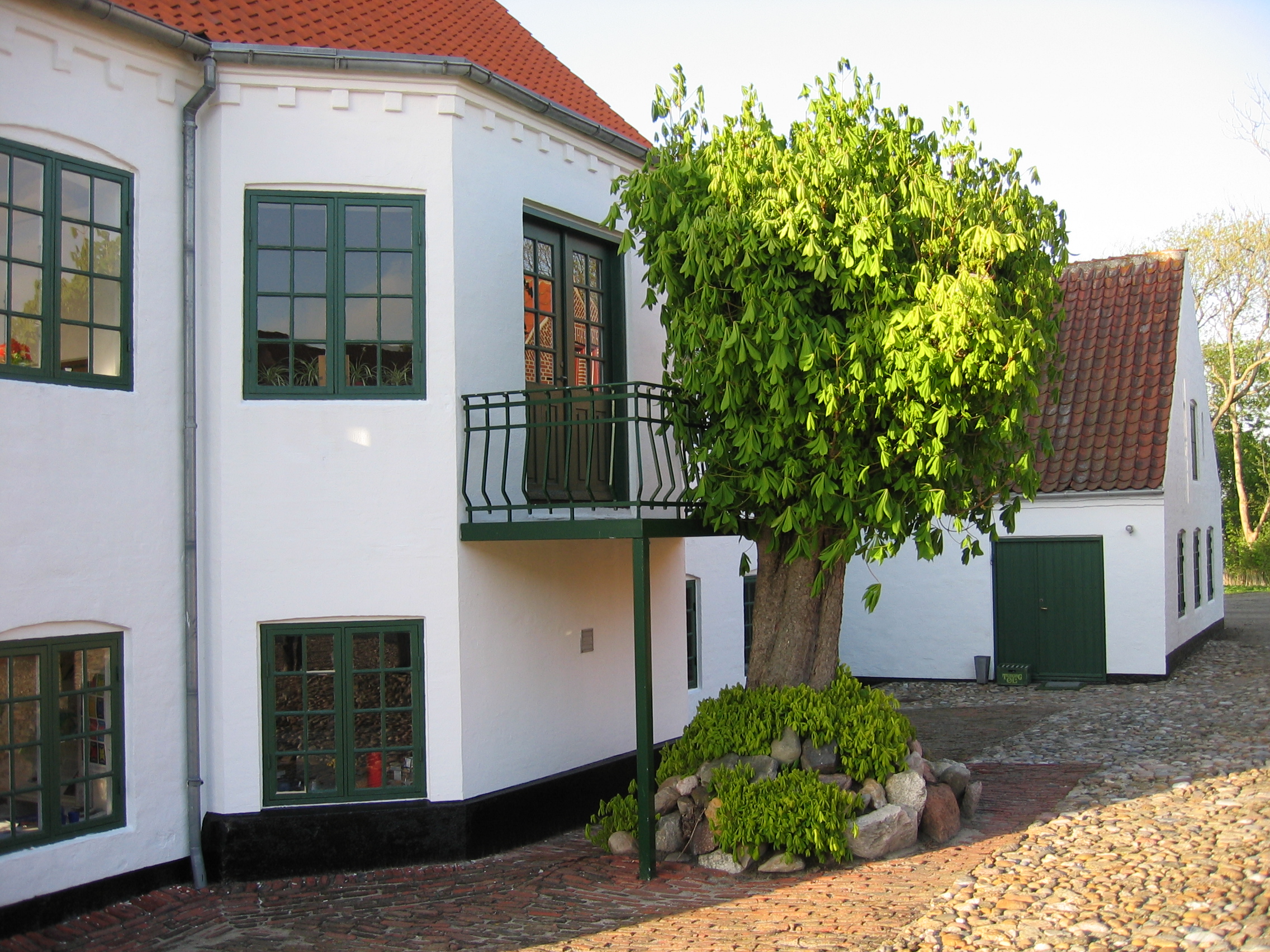About Skærum Mølle
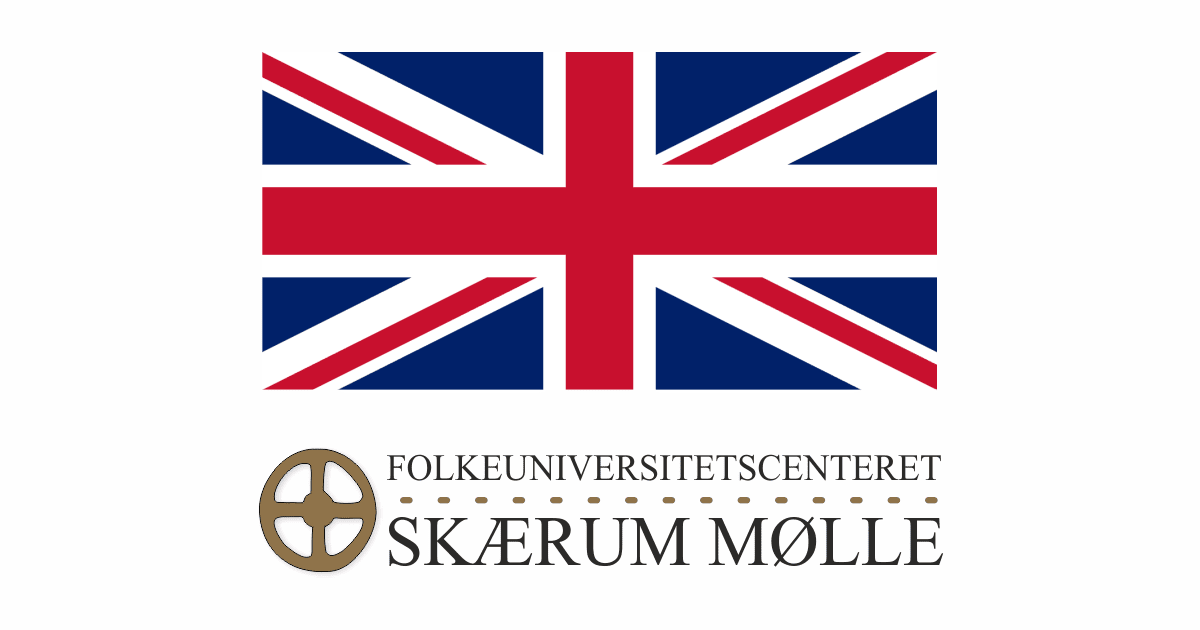
The buildings Skærum Mølle (mill) is owned by the Folk University Centre.
Skærum Mølle is situated in a beautiful area where Lilleå (”Small Stream”) falls into Storå (“Large Stream”). As the name implies, this used to be a mill farm with a water mill and farming. Moreover, here were also brickworks and a power station, operated by the waterpower from The Small Stream.
The farm Skærum Mølle with 272 acres of land and 309 acres of wood as well as the farmhouse.
The Folk University Centre Skærum Mølle has a wing with guest rooms which can be rented day by day.
Single rooms: Dkk 490,00
Double rooms: Dkk 750,00
Overnight stays are used by students, golf players, people in transit, fishermen, tourists, people attending events at Skærum Mølle, and people who have short term jobs in the area.
You are very welcome to stay overnight at Skærum Mølle when we have available rooms.
Booking must be made a day before your arrival.
Rooms must be left at 11 o’clock on the day of departure.
Breakfast is included in your stay and is served in the white house in “Pejsestuen”.
With us you can pay cash or book your room online here.
Rooms and apartments
Rooms and apartments are in the old barn, a wing of Skærum Mølle. All rooms have a private bath and toilet.
Rooms at Skærum Mølle
In a wing of Skærum mølle there are both single rooms and double rooms. All rooms have a private bath and toilet.
Prices:
(incl. bed linen & towels)
Single rooms 490 dkk per night
Double rooms 750 dkk per night.
With us you can pay cash or book your room online.
Do you have questions? Call +45 9748 1322
Apartments at Skærum Mølle
Skærum Mølle has 2 nice apartments for rent. The one apartment has room for 5 people and the other has room for 6 people. Both apartments have their own kitchen with refrigerator, stove, and a private bathroom.
Prices:
Renting is for 7 days and the price is 5000 dkk.
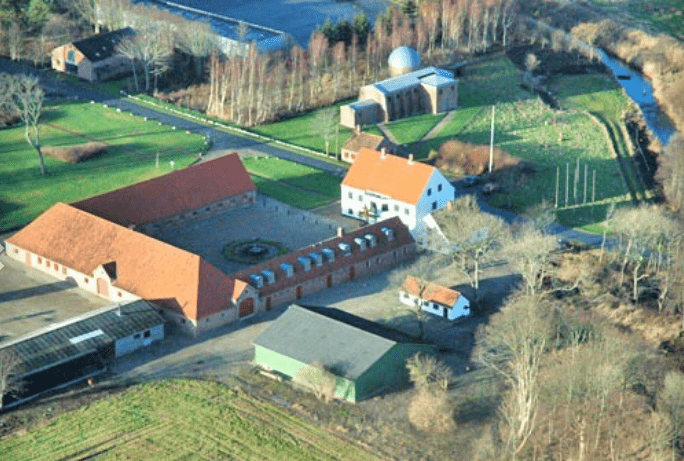
Or contact us by Telephone: +45 9748 1322
What is a Folk University?
The Danish Folk University started its work in 1898 and it consists of app. 150 Folk University committees and sections. As part of the Danish general education these must spread the knowledge of the results and working methods of science, meaning that they are places, where the society meets the scientific world.
The Folk University Centre Skærum Mølle
The independent institution Skærum Mølle was founded in 1986. The purpose is to strengthen the idea of the Folk University as a connecting link between science, art, and society. Further, to run this as a centre for development of democratic and open university education. The Folk University Centre forms the practical frames of lectures and seminars and is a centre of exchange of knowledge and experiences between many different groups.
The buildings were purchased in 1987 and have been restored for means that were collected from a number of public and private subscribers.
The buildings and the architecture
The Folk University Centre Skærum Mølle consists of:
Main building (the white house), built in 1865 by titular Councillor of State Mr. A.E.M. Tang, owner of the manor Nørre Vosborg. He was well-known because of his efforts in educating the farmer class. The farm buildings from 1928 and the large pensioner’s house from 1914, built by the then owner Mr. Niels Villemoes who was inspired by the national league “Better Architectural Style”.
The farm buildings consist of:
East wing: Former farm hands’ rooms, converted into flats, rooms and study rooms when restored in 1988.
West wing: Former cowshed. First floor: Department of development of tourism, and rooms on the ground floor (1996 and 1998).
The barn: Hall for lectures, exhibitions and theatre, restored in 2001.
Further buildings to visit:
Brickworks Museum, The House for Stones and Stars and The old Co-op Museum
The nature surrounding Skærum Mølle
The situation in richly varied natural surroundings contributes to making Skærum Mølle a special place. The streams Lilleå (“Small Stream”) and Storå (“Large Stream”), woods, fields and meadows encircle the old mill farm which has a long and exciting history. Here people have lived since antiquity. Finds from the Stone Age and the Bronze Age have been made in the fields. Moreover a Viking grave has been found in Grydehøj, north of Skærum Mølle. This was an attractive place to live, mostly because of the streams (fishing and water mill), clay in the subsoil and meadows for grazing.
The nature surrounding Skærum Mølle and the neighbouring manor Nørre Vosborg offers good possibilities of walks.
Exhibitions
1. The Welcome House
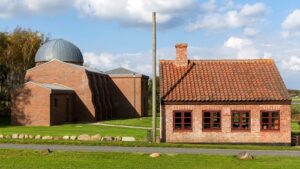
The former smithy of Skærum Mølle is today a Welcome House. It dates back to 1875. The humble building was in the late 19th century the setting for the inventive talents of Niels Villemoes, the owner of Skærum Mølle, and millwright Peder Thrige. Here they created among other things new types of brick-and-tile-making machines and agricultural machines, further they developed a power station in co-operation with Professor La Cour of Askov Folk High School.
The old smithy which today houses the Welcome House also used to be a Brickworks Museum, and the building used to be part of Nørre Vosborg Brickworks. Originally the brickworks were placed near the manor Nørre Vosborg, but the brick manufactoring was moved to Skærum Mølle in 1882 by the then tenant and later owner Niels Villemoes. The modern and well-functioning brickworks worked until 1957.
2. The Stone House
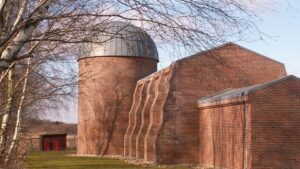
The house holds an exhibition of stones and minerals, a considerable study collection, collected and donated by the amateur geologist Mr. Carlo Møller from Holstebro. A sun observatory is in process of construction. South of the barn is an observatory with an astronomic telescope.
Running events, lectures and courses with experts of geologic and astronomic topics are arranged, including open star evenings once a month. The astronomer Ph.D. Lars Petersen is attached to the centre.
The artist Per Kirkeby says (1996):
“I am fond of working with bricks because they remind me of buildings and atmospheres that fascinate me. From the large castles and town halls to the builder houses of the suddenly growing provincial towns – or think of the large brick buildings of the second half of the 19th century and the first decades of the 20th.
All these on the whole quite despised buildings an extremely expressive – and this is what bricks are able to: form part of ornamental sequences. With bricks you can build houses that decorate them-selves. Saw-tooth courses, just one roller course and a single relieving arch gave the bricklayer a daily pleasure in building. When I use bricks this is not just a smart frame, it is also a kind of manifesto against all the much too modest buildings with which we are now forced to be content.”
The stone circle
The stone circle east of the Per Kirkeby house is a copy, based on constructions that are known from the small forest Tingskoven in the province of Han Herred. It is made of stones which were found on the land round Skærum Mølle. Such constructions are supposed to have worked as a sort of astronomic calendar in antiquity. Via sight lines the stones are marking the red-letter days of the years as for instance solstice and equinox.
3. The old Co-op museum
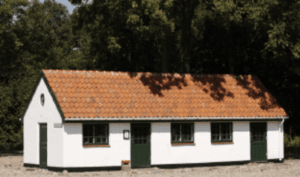
An example of a shop from the establishing of the co-ops in the years 1910-1915.
The old Co-op is established in the former hen house of Skærum Mølle, and the building holds furniture, merchandise etc., collected from quite a number of co-ops – mostly in West Jutland. Here you will see wooden shoes, chewing tobacco, coffee substitute, soap, coffee-pots (the characteristic “Blue”), nails, wartime ration coupons, cash registers and herring barrels.

